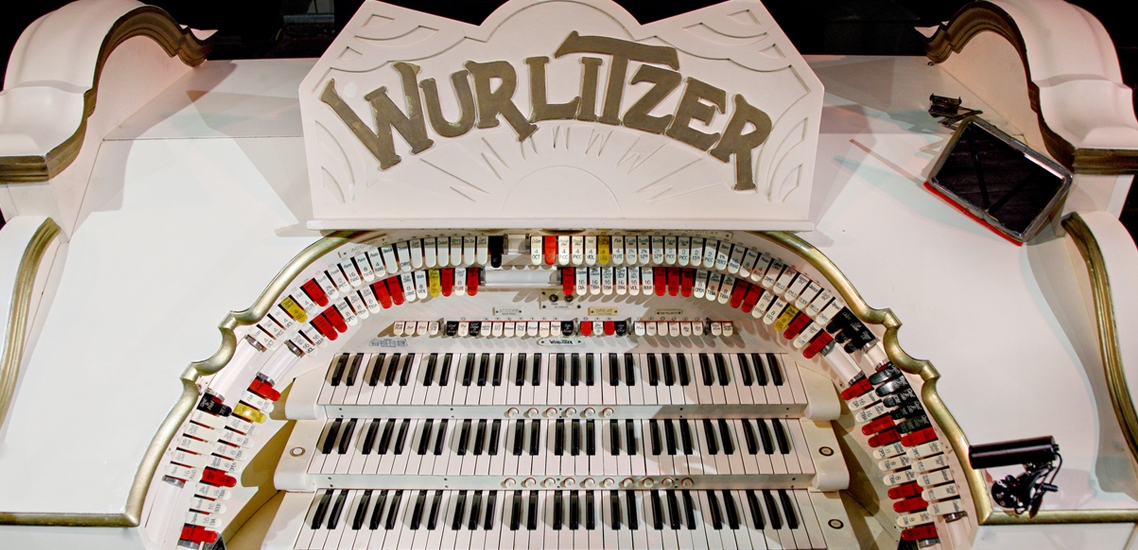The Wurlitzer

Bid me discourse, I will enchant thine ear'
Shakespeare's Venus and Adonis
Step into the sensationally stylish Blackpool Tower Ballroom and prepare to be lost in a world of elegant charm and refined beauty.
Dating back to 1894, The Blackpool Tower Ballroom is world famous for its unique sprung dance floor and spectacular architecture and remains to this day a destination for dance fans from across the globe.You can dance the day away to the sounds of the famous Wurlitzer organ amidst this stunning setting, or watch from the side lines as you enjoy a delicious afternoon tea. Whether you want to glide around the dance floor, relax at your table or spectate from up on the balconies, The Blackpool Tower Ballroom is an experience you will never forget. You’ll be entranced by magic of The Ballroom and want to return time and time again, as so many of our regular guests already do.
Click on the link below for more details.
https://www.theblackpooltower.com/attractions/the-blackpool-tower-ballroom.aspx
The present Ballroom organ is the second of that make in the Ballroom – the earlier instrument of two Manuals and ten ranks was enlarged to form the basis of the Empress Ballroom organ in 1935. Installed in 1935, the Tower Ballroom organ was originally of 13 Ranks and had added to it the fine Tuba Mirabilis in the Solo Chamber to make it its present size of 14 ranks.
Reginald Dixon
This instrument was designed by Reginald Dixon, the third of the Ballroom organists – two previous holders of that post being fine organists but not able to play for dancing. There are seven Flue Ranks and seven Reed Ranks, operating on two wind pressures, 10 and 15 inches w.g. (water gauge) – about 5 times higher than a normal church organ. A Watkins and Watson ‘Discus’ Blower provides the wind for the organ.
The Tower Wurlitzer continues to be played almost on a daily basis all the year round, for dancing, concerts, recordings and broadcasts. So much in demand is the organ, that it is often difficult to fit in the annual maintenance required for replacement of worn parts, releathering and tuning etc. All the original organ is there but in recent years the following modifications have been made;- substitution of the original Bechstein grand piano by an electronic Midi module (the original is still there and capable of reconnection), an electronic relay connecting the console to the organ pipe work, a Blower Motor Soft Starter and an electronic piston setter making registration changes at the console a simple matter.
There are 1034 pipes, two Tibias (Main and Solo), three String Ranks, two Tubas, a Diapason, Flute, Krumet, Saxophone, Orchestral Oboe, Kinura and English Horn. There are eight Ranks in the somewhat crowded Main Chamber, six Ranks in the Solo and an unenclosed side Chamber contains the Xylophone, Crash Cymbal, Chrysoglott/Vibraphone and Action Current Power Unit. The Traps, Chimes, Glockenspiel and Tuned Sleigh Bells are in the Solo Chamber.
At the end of the 1940s, the Quint and Tierce Couplers were added, giving the Tower Wurlitzer a unique new sound and adding greatly to the registration versatility without great expense or encroaching on the already crowded chambers. These stops enable the organist to couple any Great Manual registration up to the Solo Manual at either 10th or 12th pitch – adding brilliance and piquancy to the sound. Many British theatre organ installations have since seen fit to add these couplers, which were believed to have originated in the BBC’s second theatre organ, a 5/27 Moller. Formerly Reginald Foort’s ‘Travelling’ Organ, it was installed after the second World War in the Jubilee Chapel in Hoxton, London. This make of unit organ regularly added ‘Off Unison’ couplers to its organs.
In the Solo Chamber, what is thought to be the remnants of the original ten-Rank organ are a four-shutter set made of oak.
In high winds the longer pipes in the chests can be seen to sway continually and gently.
A tone chute directs the sound from the organ chambers down onto the stage and centre of the ballroom floor.
The organ has been amplified for many years so it can be heard adequately when the Ballroom is full.
The swell pedal rubbers are replaced annually when they become worn right through to the metal.
For many people, Blackpool is the Tower, the Tower is the Ballroom and at its heart, the Wurlitzer organ – long may it remain so.
© Tim Moody



